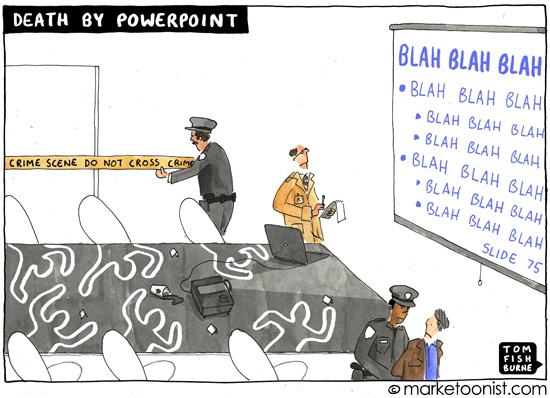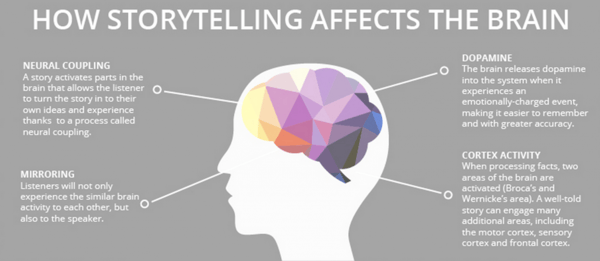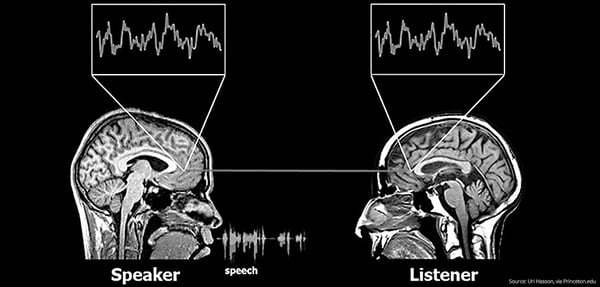I am willing to bet that when you’re tasked with giving a presentation at work, the first thing you do is load up PowerPoint or an equivalent programme on your computer. However, by presenting yourself with a blank canvas that you feel compelled to fill, you are giving yourself further hurdles to jump before you even know what it is you’re going to say!

We all know that ‘death by PowerPoint’ is a real thing. Too many presentations are delivered from a deck of slides that are densely populated with text and try to perform a sort of visual information dump on the audience. The problem with this approach, of course, is that whilst what you’re saying might make its way into your audience’s minds, it doesn’t stick, and most people will leave the room without a clear sense of what you said or what you wanted from them.
What’s missing, in almost every case, is connection. Without a genuine connection between you and your audience, it’s unlikely that your presentations will ever reach their full potential. Now, I’m not saying that your presentations at the moment aren’t effective at all. It is still possible for you to be giving perfectly acceptable presentations, even very good ones. But what I want to share with you is how one small tweak to how you approach your presentations can open up a whole world of possibilities, and help you to be consistently at the top of your game. So, before you start reaching for those generic PowerPoint presentation templates for the millionth time, let me invite you to open your mind to the power of storytelling.
The power of stories
“People don’t believe what you tell them. They rarely believe what you show them. They often believe what their friends tell them. They always believe what they tell themselves. What leaders do: they give people stories they can tell themselves. Stories about the future and about change” - Seth Godin, Tribes
This quotation, taken from Tribes, Seth Godin’s influential book about leadership, touches on something that we all probably know to be true without understanding exactly why: stories are powerful vehicles for change. When you give a presentation, you’re almost certainly trying to convince your audience to change in some way. Whether you’re a consultant pitching for new business; or an employee giving an internal presentation about a new initiative, the desired outcome requires a certain amount of change in the minds of your audience.
This isn’t all just airy-fairy management speak, either. It’s based on a solid understanding of how the brain reacts to different kinds of information. Storytelling stimulates a whole host of areas in the brains of our audience that dry data or facts simply don’t. So, when we’re listening to a speaker who is presenting us with only facts and detail (and no story), only two areas of our brains are activated – Wernicke’s area, which is responsible for language comprehension; and Brocca’s area, which looks after language processing. This means that when you’re listening to the average workplace presentation made up of a series of bullet-pointed facts, your brain is focussing on the words, while the content isn’t really sinking in.
When you listen to a story though, real magic happens. Your motor cortex is engaged, capturing the movement of what’s being said. Your sensory cortex and cerebellum start to register the tactile aspects of the story. Neurones in your olfactory cortex, your auditory cortex and your visual cortex all start firing. When a story is being told, your brain feels like it is literally being transported out of the conference room and into another world.

What’s more, as your brain is more engaged in this state, everything that you experience becomes more memorable. Neuroscientists aren’t quite certain how memory works exactly, but they do know that memories are more sticky when they are housed in multiple areas of the brain and captured through more than one of our senses.
One of the areas of communication we work on at London Speech Workshop centres on passion, and how to let that come through in your communication. Creating an emotional connection with your audience, especially in a professional setting, might sound quite alien, but it’s vitally important. Yes, it’s unlikely that you’re going to need to connect with a professional audience over sadness, grief or even delight. But you should be thinking about how to connect with them over your excitement (for a new project, say), or your conviction that the strategic decision you’re putting forward is the correct one. For more on this, have a read of our blog: What is vocal charisma and how can we achieve it?
Well, there’s good news, because stories have a role to play here, too.

A study conducted by researchers at Princeton University found that stories have a remarkable effect on the emotional responses of listeners. The researchers discovered that the power of stories to provoke deep-seated emotional responses (like those I mentioned above), creates an effect called ‘neuro coupling’. Neuro coupling occurs when the speaker and listener are experiencing simultaneously, the same emotional response to a stimulus. The upshot of this is, to use the researchers’ words, that ‘the greater the speaker-listener coupling, the greater the understanding’. So it seems that stories don’t just create excitement in your listeners, but they actually forge a live sense of connection with the speaker. And what's more, this heightened experience of connection actually helps them your audience to better understand your message.
How to use stories in your presentations
So I hope I’ve convinced you that stories are vitally important in giving compelling presentations and that, if you aren’t already, you should be using storytelling in every presentation you give. Of course, it goes without saying that you shouldn't fill your PowerPoint presentation with text - that's a sure-fire way to switch your audience off - use simple visuals to keep them inspired whilst focussing on what you're saying. But the question still remains – how do you use storytelling effectively? So here are a few effective PowerPoint presentation tips you can start to use right away:
TIP 1 - Think of your story’s structure
Use the simplest story structure imaginable, and think in terms of a beginning, a middle and an end. If you’re delivering a pitch for new business, then the beginning is a chance for you to tell the story of what the client’s business looks like now and convince them that you understand any problems they’re facing. If you like its also an opportunity to present yourself as the proverbial hero or heroine, coming to save the day. The middle is the space where you talk about how you’re the solution. It's where you introduce the tension and conflict in tip 2, below. The end is what the business looks like once you’ve come on board and provided that solution. It is your opportunity to paint a picture of 'happily ever after' for your audience.
TIP 2 - All good stories have conflict
There’s an old writer’s adage that goes something like “‘The dog ate the food’ isn’t a great story. But, ‘the dog ate the cat’s food’ gives you something to work with!”. You need to create some conflict in your presentation, almost like a villain against which the audience can side with you. Think of Steve Jobs’ famous dismissal of the smartphone ‘stylus’ when launching the original iPhone – he instantly got the audience on his side against something that many of them would have been using on a daily basis and had with them in their pockets as he was speaking!
TIP 3 - Get your script nailed, before opening PowerPoint
You want the focus to be on what you’ve got to say, not on the slides you use to illustrate it. Write your script out verbatim, then go back through and highlight the parts of you story that speak to your real passion. When you come to give your presentation you can emphasise those words and create the powerful connection with your audience we’ve been talking about. Then go through and highlight (in a different colour) any key points about which you’re not that passionate, but which are still important. Once you’ve done this, you’ll not only have the script for a powerful storytelling presentation, you’ll also have the outline for your PowerPoint deck.
For more on this, read our blog on how to use notes effectively in presentations.
.jpg?width=3600&name=jason-goodman-Oalh2MojUuk-unsplash%20(1).jpg)
TIP 4 - Find your values in the story
Values are a way of connecting with your own and others' sense of purpose. All values are universal, and people intuitively have a sense of their importance. Therefore if you can bring in your values, or some values into your story, it gives it a weight and impact which can make people want to sit up and take notice. Superman, for example, believed in truth and justice, and we loved him for it. His values helped drive the plot, and gave us a repeated sense of victory when good triumphed over evil.
So you should now be ready to start using some powerful storytelling techniques in your presentations. If you do, you’re likely to find your presentations have more impact and that you start to win more pitches, have more proposals accepted, and that your colleagues and managers enjoy and engage much more with what you have to say. Presenting is still a daunting prospect though - here are 5 tips for overcoming presentation nerves.
For more of our favourite PowerPoint presentation tips, make sure you're signed up to our monthly newsletter.
And if you’d like to up your game when it comes to giving presentations, then perhaps it's time to get an expert coach and guide to support you to achieve communication excellence. If you're ready to give it a try, why not book a free Discovery Call with our Client Success Manager to find out how we can help? Click here to choose a time that suits you.


